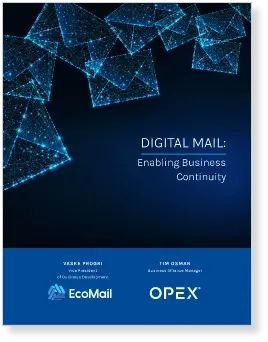60-Second Summary
Enterprise Content Management (ECM) is a crucial digital strategy that aims to improve business processes and enhance customer experiences by effectively managing, organizing, and delivering a wide range of content types. This comprehensive guide explores the essentials of ECM, highlighting its significance in the digital transformation journey of businesses moving away from paper-based systems towards more efficient, hybrid remote work environments. ECM addresses the costly challenge of information retrieval, which can cost large companies billions annually in direct and opportunity costs.
As the world becomes more and more digital, businesses globally need to continuously adopt new technology to keep up. Employees can now work remotely without coming into the office and most office tasks can be accomplished online. According to research from Gartner, 48% of employees will work remotely at least some of the time in the post-pandemic world.
Having an effective content management process in place is crucial for businesses, especially those struggling with maintaining information using paper alone or as the primary method for record keeping.

It’s important to have scalable and flexible solutions on hand to keep your operations afloat for periods of peak demand or uncertainty. We’ve put together this short guide about reverse logistics operations along with strategies you can use to optimize your supply chain, the roles automation can play, and current trends.
WHAT IS ENTERPRISE CONTENT MANAGEMENT (ECM)?
Enterprise content management (ECM) is an umbrella term for the set strategies, processes, and tools for effectively capturing, managing, organizing, storing, and delivering information within a business. Also known as content management or document management, ECM has developed to encompass digital files, social media, and web content in addition to invoices, forms, contracts, and other vital business information.
ECM is used to handle information throughout its entire lifecycle, including the capture, preserve, categorize, process, publish, archive, and removal phases to support key organizational processes for anything from human resources, accounts payable and receivable automation, to contract and invoice management. Over time, the use of ECM has evolved to keep up with digital transformation needs and includes artificial intelligence (AI), machine learning, automation, and cloud storage platforms to access and handle information faster and more accurately than ever before.
Organizations adopt ECM solutions primarily to reduce or almost entirely eliminate the time spent searching for files and handling inaccurate information. Globally, 56% of companies are currently prioritizing digital transformation to improve overall business processes and the customer experience.
Types of Content Managed with ECM
Organizations can manage a wide variety of content using an ECM system, including physical and digital media. This content can be classified into three different types of content: structured, unstructured, and semi-structured content. Knowing which type of content you work with can help decide which technologies you’ll need.Structured Content
Structured content consists of highly defined or contained data that’s intended to be processed using software. This includes content such as databases and code.
Unstructured Content
Unstructured content is information without a pre-defined format created and used by humans, including Microsoft Office documents, PDFs, and emails.
Semi-structerd Content
Semi-structured content is a combination of both structured and unstructured content. It consists of data, layouts, and formats that will need classification before being digitally processed, relying on an effective capture system to gather or identify all information and make it presentable. Semi-structured content encompasses invoices, purchase orders, receipts, and similar information that can be processed with automation or machine learning.
BENEFITS OF AN ECM SOLUTION
Organizations turn to ECM for a variety of different reasons – business continuity and disaster preparedness, securely storing information, preventing duplicate files, improved compliance with regulations, and better content accessibility. Companies with digital first strategies are 64% more likely to achieve their business goals than competitors.
Reduced Costs and Overhead
Implementing an ECM system has the potential to significantly reduce costs and overhead by reducing the time, labor, and space needed to work with physical documents. Adopting an efficient capture system with an effective document scanner and software to convert physical documents and records into digital ones can provide even more cost savings.
Increased Productivity
According to an AIIM study, ECM can improve staff productivity and engagement by around 18%. By reducing the time spent searching for files, employees can spend more time working with information and provide better customer service. An effective document capture system removes labor-intensive and time-consuming processes, enabling employees to focus more on collaboration and project management. ECM also enables remote and hybrid employees to access information more easily, helping to improve job performance.
Enhanced Efficiency
By moving to an ECM system, workflows can be streamlined and time spent trying to manage messy documents is minimized. According to Gartner, an average of four weeks each year is lost waiting on misfiled, mislabeled, untracked, or lost documents. This will improve inter-departmental communication and information handling downstream, resulting in better customer service that improves customer satisfaction.
Improved Sustainability
More than ever, prospects, customers, and legislation are putting more and more pressure on companies to be more sustainable to reduce environmental impact. Implementing ECM and adopting a paperless system not only improves sustainability, but helps to reduce resource use and overhead costs. Going paperless can improve staff productivity by nearly 30% according to an AIIM market survey.
Boosted Customer Satisfaction
ECM enables employees to access customer information and resources in a timely manner and can be used to organize information in a way that can be understood more easily, leading to improved service that helps to increase revenue. According to McKinsey, a digital transformation with a focus on improving the customer experience can create a 20-30% increase in customer satisfaction and economic gains of 20-50%.
How Does ECM Work?
ECM works by combining your organization’s digital transformation strategy with the technology necessary to effectively organize and maintain vital business information. Before moving to the next stage, information must first be captured if it is not digital. Physical documents will need to be scanned and information will need to be identified and captured, commonly with optical character recognition (OCR), which is the electronic identification of typed, handwritten, or printed text.
Once documents are in a digital format, employees can use document handling software and the ECM platform to find documents quickly by keyword search and read, edit, or print files. According to an IDC study, 42% of knowledge workers’ time is spent seeking, processing, and sharing information. Plus, workers can’t find the information they need around 46% of the time. Having the ability to easily search for all files in an all-encompassing system will minimize downtime that eats away at your business.
1. Capture
The capture piece of ECM is the way content enters the stream, whether by scanning physical documents into digital formats or creating information digitally and adding it to the system. Capturing information from physical files requires metadata that provides necessary information for record-keeping purposes. Semi-structured content, such as invoices, contracts, and reports will need to be identified and read by the system using OCR.
2. Manage
The manage component of ECM is where employees can access, manage, and modify content. This usually consists of document management, collaborative software, web content management, and records management.
3. Store
The ECM system will need to have a platform where frequently changing information is backed-up to another system or database in case files are lost. Content will need to be saved with flexible file structures.
4. Preserve
Similar to store, preserve backs-up infrequently changing information and is used more for records management to help comply with various regulations.
5. Deliver
An ECM system will need to provide employees, end-users, clients, or customers with the information they need after it has been captured, managed, and stored.

Basics of ECM Software
As previously mentioned, ECM will require certain equipment and technology to be successful. The software you choose should be flexible to match your organization’s needs, and you may need more or less features than the base software offers. Businesses are flooded with content and will need an effective way to manage it all without sacrificing employee values and needs.
KEY STEPS TO IMPLEMENT AN ECM SOLUTION:
DEVELOP AN ECM ROADMAP
Develop a roadmap of your priorities, procedures, necessary technology (scanning equipment and software), and how you’ll launch the ECM solution in your organization.
A content audit will need to be completed to provide insight into the information you have and how it needs to be handled. You’ll also need insight into how users are sharing and storing files.
What is your content lifecycle? Your roadmap will need to include how long documents will need to be retained and how information will enter the system.
How will content be handled? Create proposed rules for content governance with security, risks, and regulations in consideration.
Consider your users – what processes will help improve workflows in ways employees can be comfortable working in? Can remote and hybrid employees benefit from ECM?
Implementing ECM will require key stakeholders from the organization to focus on the company’s values, needs, and priorities and communicate the plan.
CREATE A TEAM OF STAKE-HOLDERS
ESTABLISH GOALS, KPIS, AND PRIORITIES
ECM provides many benefits, but you’ll need to focus on the ones important to your business’s success. Do you want to improve productivity? Lower overhead costs? Improve customer service? Streamline workflows to enhance efficiency? Become paperless?
Now that you have a plan, team, and goals in place, it’s time to gather the resources you need, put your solution together, and launch the new platform to your department or organization.
CONSTRUCT, TEST, AND IMPLEMENT
REPEAT STEPS AS ADJUSTMENTS ARE NEEDED
After implementing your ECM solution, evaluate your employee response, adoption, and effect on operations. After gathering this information, you may need to go back and adjust your roadmap, add stakeholders, and reimplement your new system. Ask yourself a few questions:
Has there been any resistance to the new equipment and software?
What are the effects on the way we work?
Things To Consider
Implementing an ECM solution is no small project and it’s important to consider a few things when putting your solution together:
Short and Long-Term Business Goals:Are there problems that need to be solved now that can benefit future goals? What will a long-term ECM solution look like?
Elements of ECM Already in Place:Is there software already used for managing content? Do you already have technology in place to capture information?
THE FUTURE OF CONTENT MANAGEMENT
With digital technology constantly advancing, content creation is at an all-time high, flooding organizations with unmanaged information that hurts productivity. Regardless of size, all businesses will need to manage their information and records using a form of content management.
With the move towards sustainability and the need to navigate new challenges like post-pandemic effects, inflation, changes in the workforce, understaffing, and global events, businesses, more than ever, will need to focus on their digital transformation.
Other Resources You Might Find Helpful
Top 10 Metrics to Measure Operational Success: A Warehouse KPI Checklist
Maximizing Fulfillment Center Performance
5 Signs Your Warehouse Needs an Automated Overhaul
How to Seamlessly Integrate Warehouse Automation with Your Current Operations
Increasing Distribution Center Productivity Using Automated Put Walls
Warehouse Automation 2025: The Complete Guide to Cutting Costs and Boosting Efficiency
Safety First: Reducing Workplace Risks with Automation
Leveraging Warehouse Automation for Enhanced Customer Experience in Retail
The Agile Warehouse: Modularity as the Answer to Market Volatility
Advancements in Cold Chain Logistics for Pharmaceuticals
NEXT LEVEL AUTOMATION
Unlock Operational Efficiency with OPEX
OPEX is powering the future of automation. Contact us to learn more about how our vertically integrated automated solutions can help take your business to new heights.